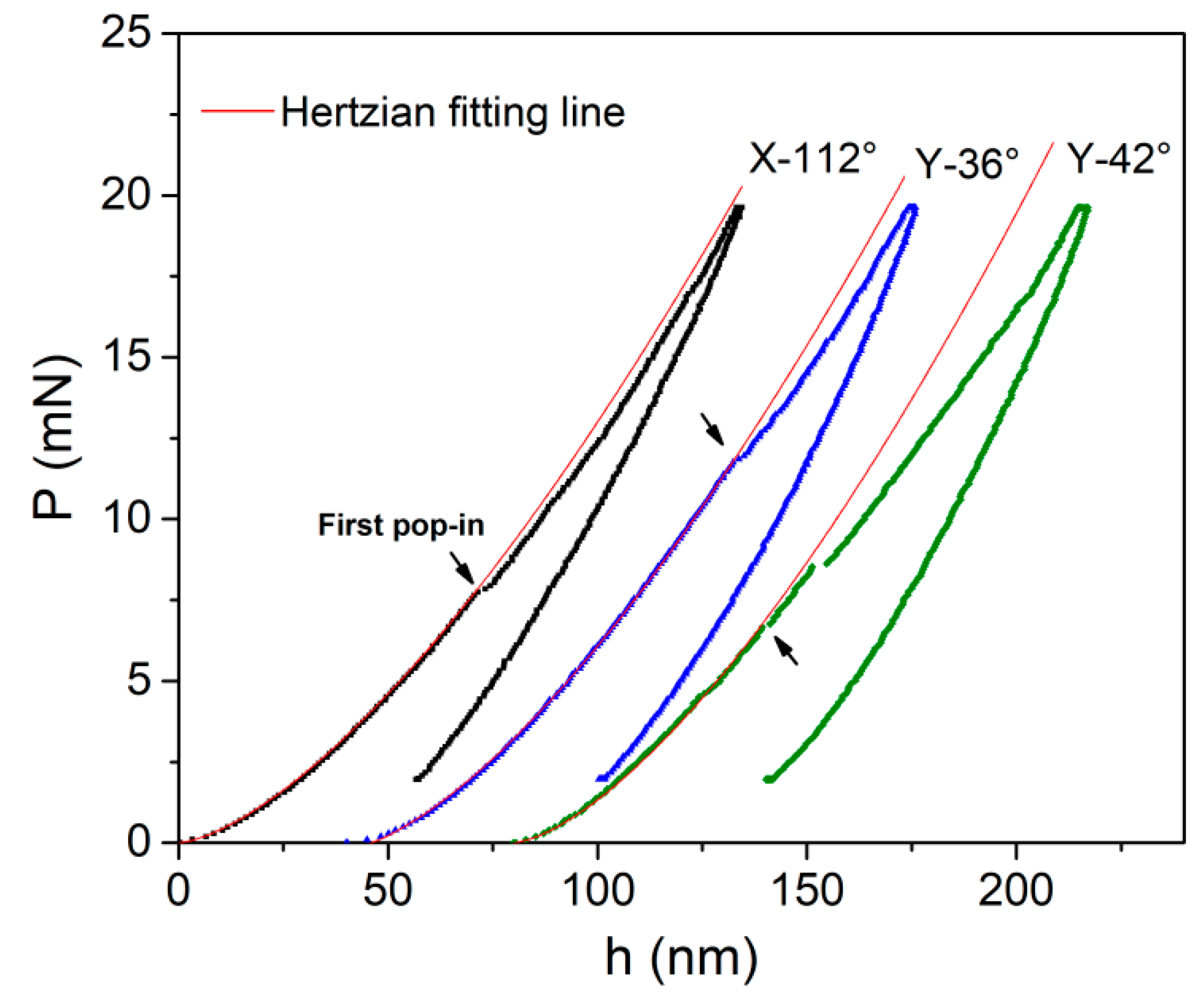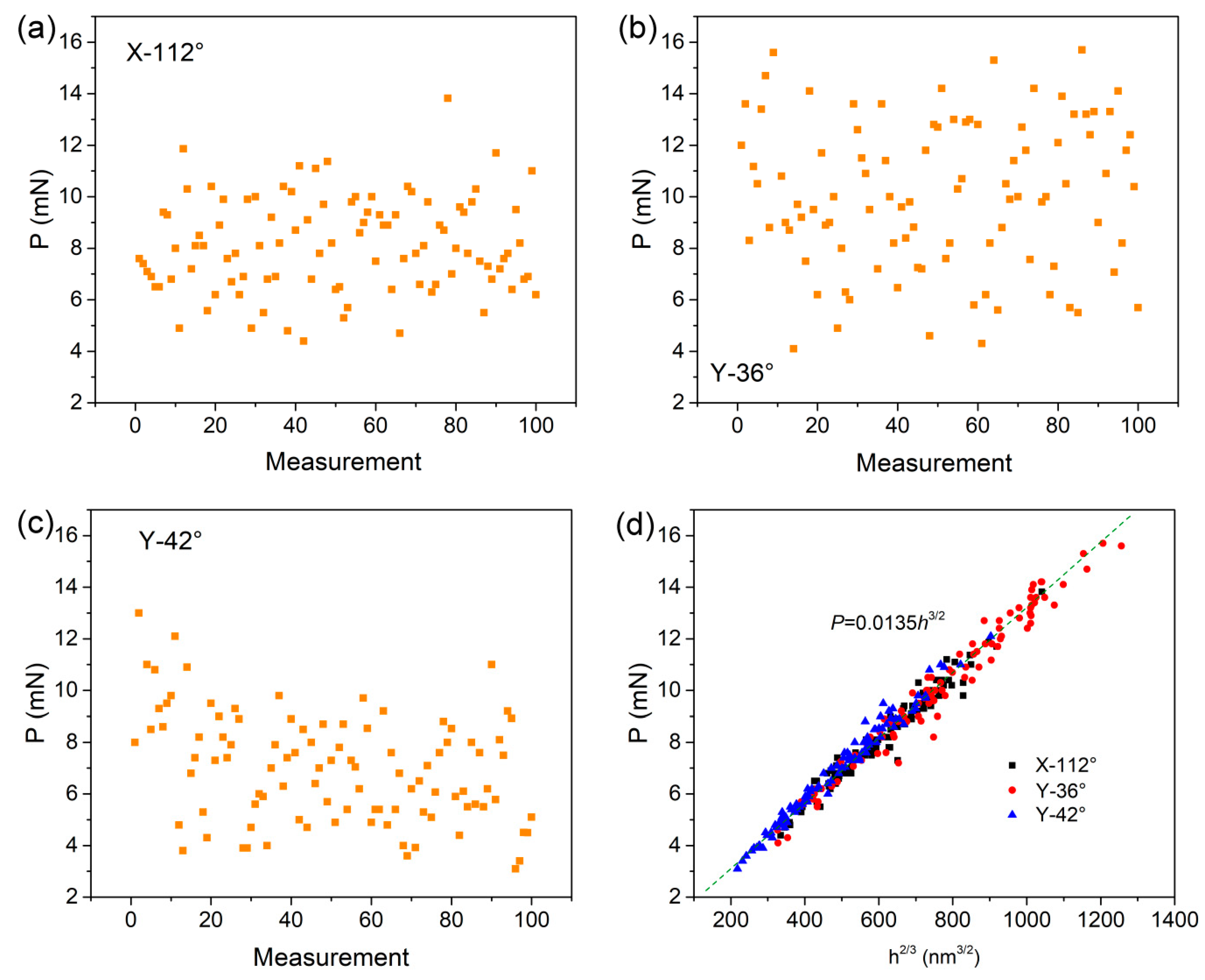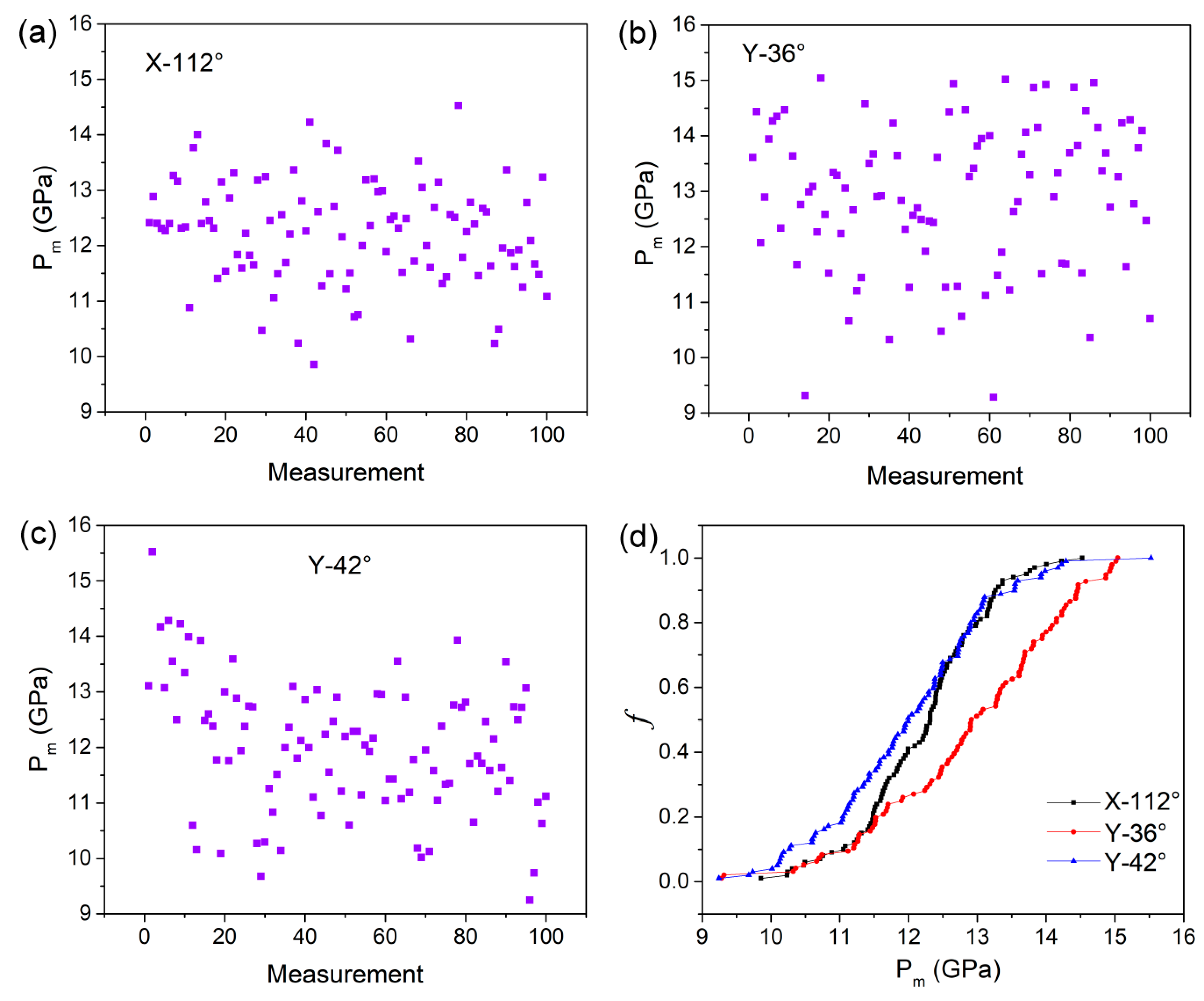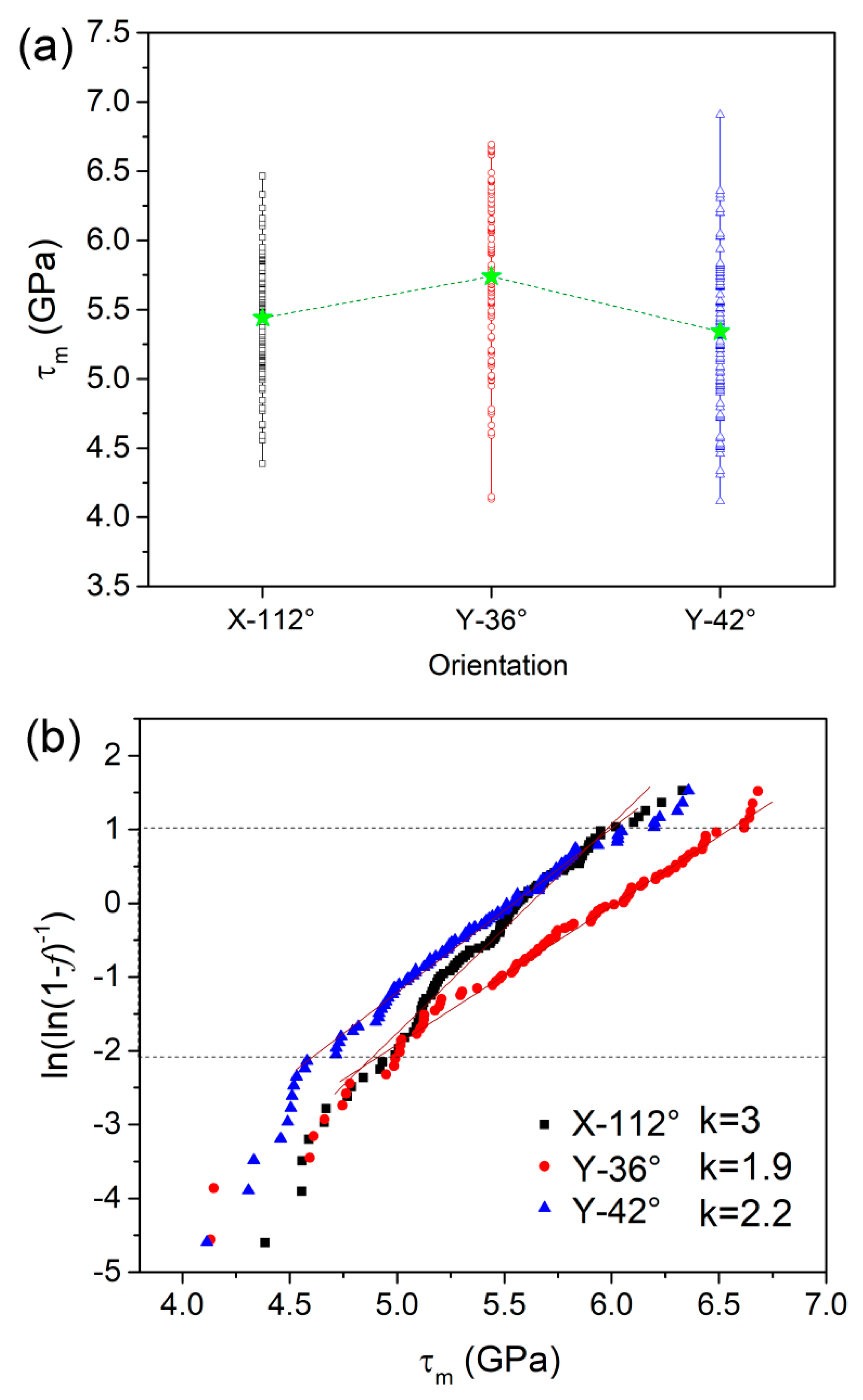Orientation-Independent Yield Stress and Activation Volume of Dislocation Nucleation in LiTaO3 Single Crystal by Nanoindentation
Abstract
1. Introduction
2. Materials and Methods
3. Results and Discussion
4. Conclusions
Supplementary Materials
Author Contributions
Funding
Conflicts of Interest
References
- Smith, R.T.; Welsh, F.S. Temperature dependence of the elastic, piezoelectric, and dielectric constants of lithium tantalate and lithium niobate. J. Appl. Phys. 1971, 42, 2219–2230. [Google Scholar] [CrossRef]
- Zu, H.; Wu, H.; Wang, Q.-M. High-Temperature Piezoelectric Crystals for Acoustic Wave Sensor Applications. IEEE Trans. Ultrason. Ferroelectr. Freq. Control. 2016, 63, 486–505. [Google Scholar] [CrossRef] [PubMed]
- Wu, Y.Q.; Huang, H.; Zou, J.; Dell, J.M. Nanoscratch-induced deformation of single crystal silicon. J. Vac. Sci. Tech. 2009, 27, 1374–1377. [Google Scholar] [CrossRef]
- Hang, W.; Zhou, L.B.; Zhang, K.H. Nanoscratch-induced deformation of single crystal silicon. Precis. Eng. 2016, 44, 62–69. [Google Scholar] [CrossRef]
- Gruber, M.; Leitner, A.; Kiener, D.; Supancic, P.; Bermejo, R. Incipient plasticity and surface damage in LiTaO3 and LiNbO3 single crystals. Mater. Design. 2018, 153, 221–231. [Google Scholar] [CrossRef]
- Gruber, M.; Kraleva, I.; Supancic, P.; Bielen, J.; Kiener, D.; Bermejo, R. Strength distribution and fracture analyses of LiNbO3 and LiTaO3 single crystals under biaxial loading. J. Eur. Ceram. Soc. 2017, 37, 4397–4406. [Google Scholar] [CrossRef]
- Zhang, Z.; Yang, S.; Xu, C.; Wang, B.; Duan, N. Deformation and stress at pop-in of lithium niobate induced by nanoindentation. Scr. Mater. 2014, 77, 56–59. [Google Scholar] [CrossRef]
- Gao, Y.; Bei, H. Strength statistics of single crystals and metallic glasses under small stressed volumes. Prog. Mater. Sci. 2016, 82, 118–150. [Google Scholar] [CrossRef]
- Ma, Y.; Ye, J.; Peng, G.; Wen, D.; Zhang, T. Loading rate effect on the creep behavior of metallic glassy films and its correlation with the shear transformation zone. Mater. Sci. Eng. A 2015, 622, 76–81. [Google Scholar] [CrossRef]
- Yang, G.; Zhao, Y.; Lee, D.-H.; Park, J.-M.; Seok, M.-Y.; Suh, J.-Y.; Ramamurty, U.; Jang, J.-I. Influence of hydrogen on incipient plasticity in CoCrFeMnNi high-entropy alloy. Scr. Mater. 2019, 161, 23–27. [Google Scholar] [CrossRef]
- Ma, Y.; Peng, G.; Debela, T.; Zhang, T. Nanoindentation study on the characteristic of shear transformation zone volume in metallic glassy films. Scr. Mater. 2015, 108, 52–55. [Google Scholar] [CrossRef]
- Abram, R.; Chrobak, D.; Nowak, R. Origin of a Nanoindentation Pop-in Event in Silicon Crystal. Phys. Rev. Lett. 2017, 118, 095502. [Google Scholar] [CrossRef] [PubMed]
- Jing, L.; Pan, Q.; Long, J.; Tao, N.; Lu, L. Effect of volume fraction of gradient nanograined layer on high-cycle fatigue behavior of Cu. Scr. Mater. 2019, 161, 74–77. [Google Scholar] [CrossRef]
- Ma, Y.; Huang, X.; Song, Y.; Hang, W.; Zhang, T. Room-Temperature Creep Behavior and Activation Volume of Dislocation Nucleation in a LiTaO3 Single Crystal by Nanoindentation. Materials 2019, 12, 1683. [Google Scholar] [CrossRef] [PubMed]
- Johnson, K.L. Contact Mechanics; Cambridge University Press: Cambridge, UK, 1987. [Google Scholar]
- Bei, H.; Lu, Z.P.; George, E.P. Theoretical Strength and the Onset of Plasticity in Bulk Metallic Glasses Investigated by Nanoindentation with a Spherical Indenter. Phys. Rev. Lett. 2004, 93, 125504. [Google Scholar] [CrossRef]
- Wang, S.-P.; Xu, J. Incipient plasticity and activation volume of dislocation nucleation for TiZrNbTaMo high-entropy alloys characterized by nanoindentation. J. Mater. Sci. Technol. 2019, 35, 812–816. [Google Scholar] [CrossRef]
- Schuh, C.A.; Lund, A.C. Application of nucleation theory to the rate dependence of incipient plasticity during nanoindentation. J. Mater. Res. 2004, 19, 2152–2158. [Google Scholar] [CrossRef]
- Ma, Y.; Ye, J.; Peng, G.; Wen, D.; Zhang, T. Nanoindentation study of size effect on shear transformation zone size in a Ni–Nb metallic glass. Mater. Sci. Eng. A 2015, 627, 153–160. [Google Scholar] [CrossRef]
- Zhu, C.; Lu, Z.; Nieh, T. Incipient plasticity and dislocation nucleation of FeCoCrNiMn high-entropy alloy. Acta Mater. 2013, 61, 2993–3001. [Google Scholar] [CrossRef]
- Mason, J.K.; Lund, A.C.; Schuh, C.A.; Mason, J. Determining the activation energy and volume for the onset of plasticity during nanoindentation. Phys. Rev. B 2006, 73, 054102. [Google Scholar] [CrossRef]
- Somekawa, H.; Schuh, C.A. Effect of solid solution elements on nanoindentation hardness, rate dependence, and incipient plasticity in fine grained magnesium alloys. Acta Mater. 2011, 59, 7554–7563. [Google Scholar] [CrossRef]
- Argon, A. Strengthening Mechanisms in Crystal Plasticity; Oxford University Press on Demand: Oxford, UK, 2008. [Google Scholar]
- Malekmotiei, L.; Samadi-Dooki, A.; Voyiadjis, G.Z. Nanoindentation Study of Yielding and Plasticity of Poly(methyl methacrylate). Macromolecules 2015, 48, 5348–5357. [Google Scholar] [CrossRef]




| Orientation | Mean Pressure Pm, GPa | Yield Stress τm, GPa | Activation Volume, Å3 |
|---|---|---|---|
| X-112° | 12.2 ± 0.92 | 5.44 ± 0.41 | 12 |
| Y-36° | 12.9 ± 1.33 | 5.74 ± 0.59 | 8 |
| Y-42° | 12 ± 1.18 | 5.34 ± 0.525 | 9 |
© 2019 by the authors. Licensee MDPI, Basel, Switzerland. This article is an open access article distributed under the terms and conditions of the Creative Commons Attribution (CC BY) license (http://creativecommons.org/licenses/by/4.0/).
Share and Cite
Ma, Y.; Huang, X.; Song, Y.; Hang, W.; Yuan, J.; Zhang, T. Orientation-Independent Yield Stress and Activation Volume of Dislocation Nucleation in LiTaO3 Single Crystal by Nanoindentation. Materials 2019, 12, 2799. https://doi.org/10.3390/ma12172799
Ma Y, Huang X, Song Y, Hang W, Yuan J, Zhang T. Orientation-Independent Yield Stress and Activation Volume of Dislocation Nucleation in LiTaO3 Single Crystal by Nanoindentation. Materials. 2019; 12(17):2799. https://doi.org/10.3390/ma12172799
Chicago/Turabian StyleMa, Yi, Xianwei Huang, Yuxuan Song, Wei Hang, Julong Yuan, and Taihua Zhang. 2019. "Orientation-Independent Yield Stress and Activation Volume of Dislocation Nucleation in LiTaO3 Single Crystal by Nanoindentation" Materials 12, no. 17: 2799. https://doi.org/10.3390/ma12172799
APA StyleMa, Y., Huang, X., Song, Y., Hang, W., Yuan, J., & Zhang, T. (2019). Orientation-Independent Yield Stress and Activation Volume of Dislocation Nucleation in LiTaO3 Single Crystal by Nanoindentation. Materials, 12(17), 2799. https://doi.org/10.3390/ma12172799





